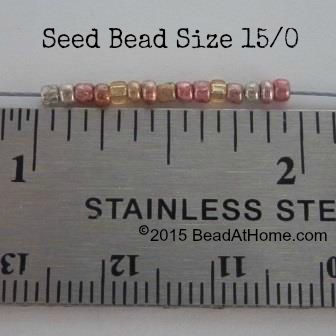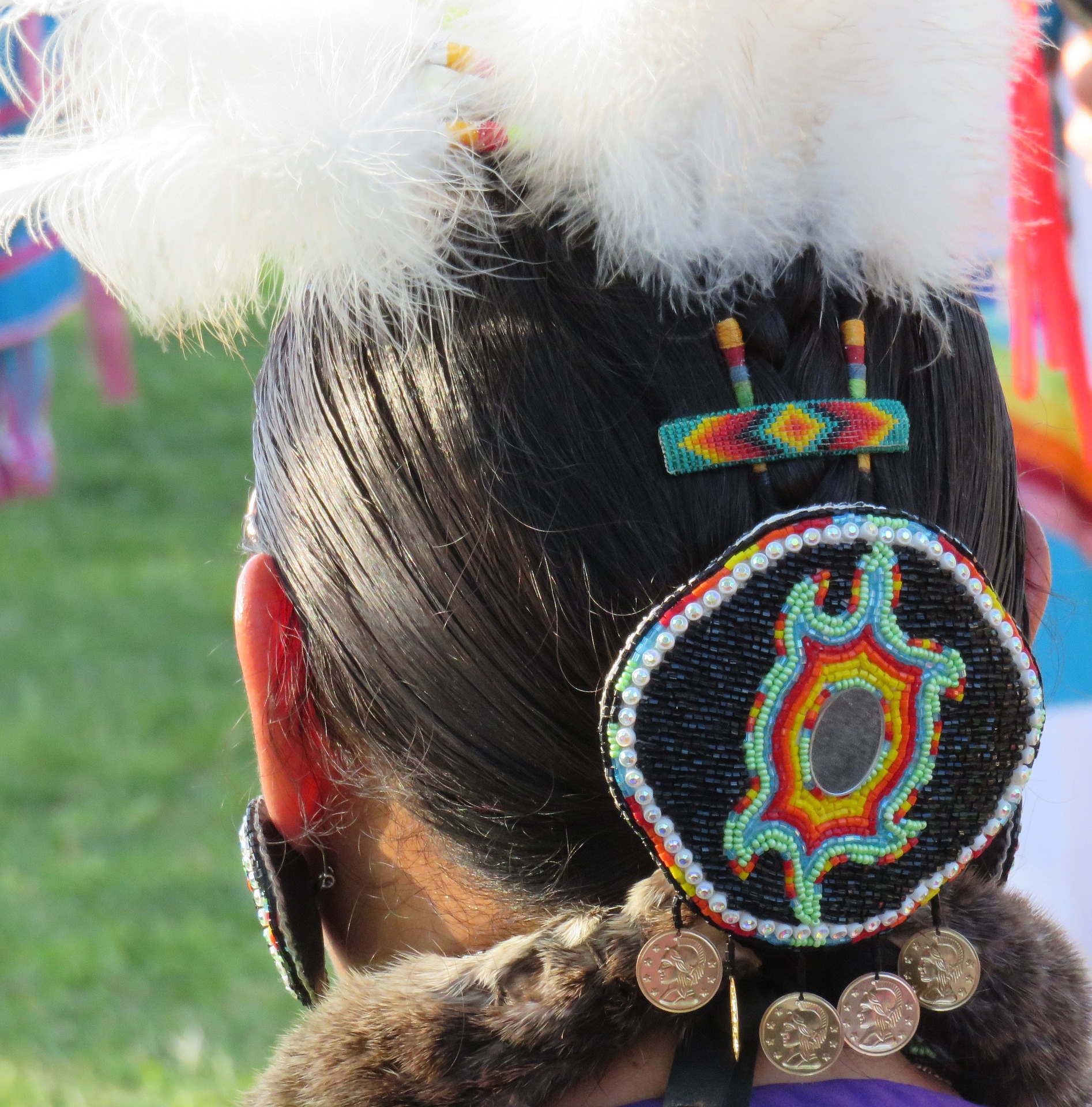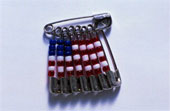Seed Beads

Seed beads...these delicious little tempting treasures that have as many uses as choices are what we will explore on this page.
Let's discuss these topics:
- Why are they called seed beads?
- What are they used for?
- What bead stringing materials should I use?
- Where do I find beading patterns?
Why Are They Called Seed Beads?
Seed beads are a generic term for ‘very small beads’, and they are in a class alone. Beads are measured in millimeters [mm]. These specialized beads are measured by these crazy numbers that look like this; 15/0 or 15° and 11/0 or 11°.
What do these numbers represent? To put it simply, the numbers represent the approximate number of seed beads that equals an inch. This is the general rule of thumb and just an approximate.
For example, 15/0 size takes approximately 15 to make an inch and 11/0 takes, you guessed it, 11 to make an inch and so on.


Now here is another little tidbit; when you hear someone say the size they will either say “size 15” or “15 aught”. Aught is what puts the /0 or ° in visual terms.
Sizing General Rule of Thumb
With different manufacturers come different methods so the number does not always represent the length. It won't be longer than an inch but may fall short of an inch of beads.

Seed Bead Sizes?
Since they are 'very small' the range of size is limited, but none the less it is not a one size fits all scenario, rest assured there is more than one size to choose from.

The smaller the size number, the larger they are.
These larger size also host a few different names; 'EE-beads', ‘crow beads’ or ‘pony beads’ and are generally the 6/0 or 8/0.
They also have larger center holes which allows them to be easily strung onto heavier thick cords or leather strands. Great for children's craft projects and macramé.
Selections abound not only with the sizes but the finishes, the colors and even the shapes. It is all a rather interesting selection to discover. Some are singe holed, some double holed. The assortment goes on and, oh my, the selection will astound you.
Half the fun with these tiny treasure is discovering what awaits you and what you will create with them.
How to Buy Seed Beads?
When purchasing materials learning the different packaging will help with purchasing decisions.
Shown in the pictures below, starting from the right, you see vials of these loose little treasure. This is a common and standard sight in beading supply aisles and how convenient to have a container to keep your treats in. The vials or tubes of seed beads are measured by ‘grams’.



Next are bags, measure by ounces, generally in color combos. We find this a quick inspiration for themed projects. Doesn't this selection here scream Halloween projects to you?
Lastly, on the far right are hanks of seed beads. Hanks are multiple strands of beads. These strands may measure 8-inches in length on upward to 20-inches in length.
Each of these packaging and display of product allows convenience for viewing and pouring over the selection. Maybe give each a try to familiarize yourself with the options available.
What are Seed Beads used for?
There is a wide variety of uses and having several on hand will be beneficial. Seed beads should be a standard supply in any beginner jewelry supply kit.

Just a few of the most commonly use for these tiny treats are:
- Weaving: Bead weaving, either on loom or off loom, is a very popular technique with endless designs and patterns. Do a little research and you will see for yourself. Learning different stitches will keep you busy.
- Embroidery: Hand embroidery embellishment on either garments or accessories such as wedding dresses or handbags are a common use.
- Decorative Uses: Note in this picture above the beads have been used as a utility purpose creating a decorative finished loop to hold other components.

Native American or Tribal garments are a prime example of incorporating seed beads with jewelry making and embroidery. There is a long, rich and interesting history behind these little delights. The uses are endless. They are fun to play with providing hours of creative diversions. You will find many uses for them other than what I've summarized here.
Keep your eyes open and you will begin to notice them everywhere used in such creative ways. How do you see them used?
What Stringing Materials to Use?
We repeated say there is a variety. We feel rather redundant but it is a fact that variety is necessary for options of preference in taste. How boring it would be if there was only one way. Varieties = Creativity. Stringing materials available and based on the size of the bead hole can either increase or narrow your selection.

Bead weaving consist of sewing the beads together using bead needles. Silk and nylon threads are typically used if you are going to be weaving, these threads need to be thin enough for multiple strands of thread to pass through the hole.
There are a few weaving threads recommended. Allow us to introduce you to just one name brand that is beadweaver's choice material. 'Fireline'...is a specially treated thermally fused polyethylene. Here is one bead-weaver's take on using Fireline for weaving, Patrick Duggan Designs.

Beading Tip:
Fireline beading thread started out as a fishing line thread. The beading world found it and began using it for weaving. The company re-manufactured the thread to market to the beading community. It is still available in fishing tackle departments.
For the larger holed seed beads, ee-beads, pony beads or crow beads there are satin and leather cords. With a larger holed bead a larger cord is more practical to use.

Beading wire or thin wire is also an option based on your personal needs.
All of these stringing materials are available in a variety of diameters and your needs will be determined based on each individual project you create. Take a moment to watch this informative video that covers some really great basic info for weaving threads. We believe it will de-mystify some of this for you.
Bead Thread Overview
There is a lot of information to take in and digest but what a wealth of information there is in this introduction to beading thread for seed beads.
Beading Patterns?
There are many places both online and offline when looking for beading patterns.
There is lots of fun to be had and can be very addicting. Here is a prime example of what a seed bead addiction can create in you. One of my beading buddies, Marilyn Southmayd, has been so taken with working with seed beads that she has written her own book to help and encourage others with this.

Her story is like most of us, we start at the beginning with beading and then allow it to take us where it calls us. Marilyn's passion took her to bead weaving and then a step further, writing about it. This is a sample of some of her work.
Marilyn has been such an inspiration to us personally to see what can be done with these treasures. We have been able to see them with new eyes never realizing just the possibilities out there.
What Else Do I Need to Know?
One thing we always like for you to remember is that as a beginner you don't know what you don't know. It's just that simple. Exploring and digging for information is never ending but it can turn up lots of information to help in your journey.
This is a mere introduction on the topic but hope it's been helpful. There is still much more to learn.



We found an informative article from Fire Mountain Gems, ‘Seed Beads 101’ that has a great explanation and expands more. You will find charts of sizes and shapes plus articles for more history of seed beads. There is even a printable PDF forms for graph paper to create your own patterns based on the type of stitch you would like to use. Fire Mountain Gems is one of our favorite go-to websites for knowledge about any kind of bead work.

Your other companion for learning will be YouTube. Lots of videos for the different stitches, types of threads and oh so much more!
We hope you enjoy the journey in your exploration with your projects and your new discovery with seed beads and we invite you to share your projects with us. We get our best inspiration from each other.








